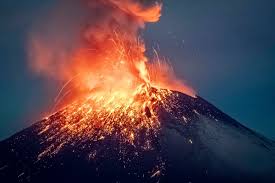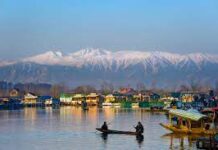The eruption of volcanoes or volcanic eruptions is one of the important factors that affect short-term climate variability and change. Volcanic eruptions have an impact on the change and balance of the atmosphere due to the entry of gases and volcanic particles into the atmosphere.
The magnitude of the impact of volcanic eruptions on climate change depends on the magnitude of the volcanic eruption and the height of volcanic particles reaching the atmosphere. These particles cause a reduction in solar radiation (attenuation) through absorption, scattering, and reflection processes. As a result, the surface air temperature of the Earth decreases and changes to become cooler.
Only Volcanic Eruptions with Strong Explosive Power Can Cause Climate Change
Natural events that actively increase the amount of aerosols in nature, especially in the upper atmosphere, are volcanic eruptions. Some volcanic eruptions that carry aerosols into the stratosphere include the eruptions of Mount Tambora (1815), El Chichόn (1982), Pinatubo (1991), and Kelud (1919).
Not all volcanic eruptions cause climate change. However, only volcanic eruptions that contain a lot of sulfur oxides and have strong explosive power. Their eruptions can change the composition and stability of the atmosphere. Thus, their eruptions can carry volcanic particles into the stratosphere which can affect the composition and stability of the global climate.
Mechanism of Climate Change Due to Volcanic Eruptions
Strong and sulfur oxide-rich eruptions can cause global climate change, but it is short-term in nature. Strong eruptions are eruptions with explosive power that can carry large amounts of volcanic particles into the stratosphere. The magnitude of the impact depends on the amount of sulfur oxide gas volume carried to the stratosphere by the volcanic eruption.
Aerosols are a collection of solid or liquid particles suspended in a gas medium. Their size ranges from 0.001-100 μm. The distribution of aerosols (sulfur oxides) with altitude depends greatly on the season and location. In general, the aerosol content in the atmosphere will decrease with increasing altitude and become zero at an altitude of 35 km.
After sulfur oxide gas reaches the stratosphere, it then combines with saturated vapor to become sulfuric acid (H2SO4) and sulfate particles (sulfurous aerosols). When the stratosphere is stable and without precipitation, sulfurous aerosols remain suspended in the stratosphere for a long period, up to several years.
Aerosols settling in the stratosphere then interact with solar radiation. Their interaction absorbs solar radiation, causing stratospheric heating and reducing the amount of radiation in the troposphere. Aerosols also scatter some of the solar radiation back into space. This can contribute to cooling the Earth’s surface.
A series of volcanic eruptions cause the layer of sulfurous aerosols to permanently settle in the stratosphere, and sulfur oxide emissions sometimes thicken the stratospheric sulfurous layer. Thus, strong volcanic eruptions rich in sulfur oxides cause short-term global climate change and variability.
Monitoring Aerosol Distribution in the Stratosphere
Monitoring and researching stratospheric aerosols can be done in several ways, both in situ and remotely. This time, we will discuss 2 ways of monitoring aerosol distribution. Namely, measuring vertical aerosol distribution using Optical Particle Counter (OPC) and Light Detection and Ranging (Lidar). Both are reliable devices for long-term aerosol monitoring.
The further the aerosol spread, the more its concentration decreases. Aerosols in the stratosphere have a longer lifespan than aerosols in the troposphere. This is associated with their impact on climate change processes.
Several Volcanic Eruptions in the World that Cause Climate Change
Volcanic Eruptions in Indonesia
In the world history record, there are 2 volcanoes in Indonesia that have ejected volcanic aerosols in large quantities, namely Mount Kelud and Mount Tambora. One of their eruptions, the eruption of Mount Tambora, caused the phenomenon of the “Year without Summer.”
First, the eruption of Mount Kelud in 1919 ejected aerosol dust in large quantities, up to an altitude of more than 10,000 meters. At low altitudes, aerosol dust spread eastward and expanded to Bali, while at higher altitudes, aerosol dust spread westward.
On February 14, 2014, Mount Kelud erupted again and caused gravel rain, felt up to a radius of 10 km from the center of the eruption. It was observed that almost the entire Yogyakarta area was covered by dense volcanic ash and was estimated to reach a thickness of 2 cm, exceeding the thickness produced by the eruption of Mount Merapi in 2010. Visual imagery conducted six hours after the eruption showed that the Kelud ash cloud had reached an altitude of 18-20 km in very large quantities, with the Kelud ash cloud peak reaching an altitude of 26 km.
Second, the eruption of Mount Tambora in 1815 was a tremendous eruption with a strength of 7 VEI or equivalent to 27 megatons TNT, ejecting magma to an altitude of 43,000 meters. A total of 30-32 km3 of magma was released far into the stratosphere and 53-58 million tons of SO2 in the first 24 hours, and this was enough to produce 93-118 Tg of stratospheric sulfate aerosols. Its fine ash penetrating the stratosphere had caused a decrease in temperature in the northern hemisphere.
Due to the large number of aerosols concentrated in the stratosphere. Thus, the spring and summer seasons in countries located in the northern hemisphere in 1816 experienced prolonged winter. And almost did not experience summer at all. The condition that lasted for more than 3 months caused extensive crop failures in northern hemisphere countries and caused a drastic increase in food prices.
Volcanic Eruptions Outside Indonesia
Mount Pinatubo and El Chichόn are 2 volcanoes whose eruptions have intrigued researchers around the world. Their eruptions also contributed significantly to scientific progress in the world of science. Their eruptions also increased aerosol content suddenly by more than 100 times from the average background content of 5×10-5 sr-1.
First, the eruption of Mount Pinatubo in 1991, this volcano is located in the Philippines. The amount of aerosols scattered in the atmosphere is estimated at 30 Tg, but the amount is still much less compared to the estimated aerosols released due to the eruption of Mount Tambora in 1815. However, even though the magnitude of the eruption was not as great as Tambora’s eruption, the eruption of Pinatubo still had a significant impact on global climate change.
The eruption of Mount Pinatubo in 1991 released a lot of sulfur dioxide gas into the atmosphere. As a result, sulfate aerosols were formed and reached the stratosphere, forming a large layer of sulfuric acid droplets. The sulfuric acid droplets spread around the Earth and reduced the amount of sunlight that reached the surface of the Earth. This caused the average global temperature to decrease by about 0.5 to 0.6 degrees Celsius for about a year after the eruption.
Second, the eruption of El Chichόn in 1982, this volcano is located in Mexico. El Chichón’s eruption was not as large as Mount Pinatubo’s eruption in 1991, but it still had a significant impact on the Earth’s climate. The eruption of El Chichόn ejected about 7 million tons of sulfur dioxide gas into the atmosphere.
The sulfur dioxide gas released by the eruption of El Chichόn combined with water vapor in the atmosphere to form sulfuric acid aerosols. These aerosols spread around the Earth and reflected sunlight back into space. As a result, the average global temperature decreased by about 0.3 degrees Celsius for about two years after the eruption.
In conclusion, volcanic eruptions have a significant impact on climate change. However, not all volcanic eruptions cause climate change. Only volcanic eruptions with strong explosive power and rich in sulfur oxides can cause climate change. The impact of volcanic eruptions on climate change is short-term and depends on the magnitude of the volcanic eruption and the height of volcanic particles reaching the atmosphere.
By: Syifa Syauqina Aushaf
Write and Win: Participate in Creative writing Contest & International Essay Contest and win fabulous prizes.
















